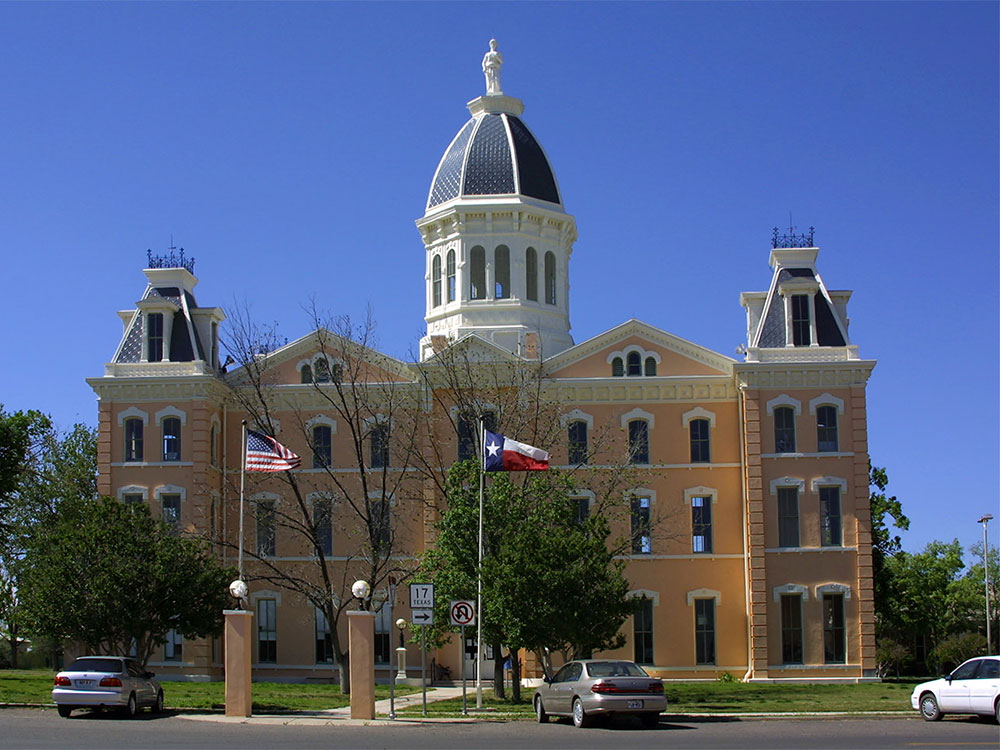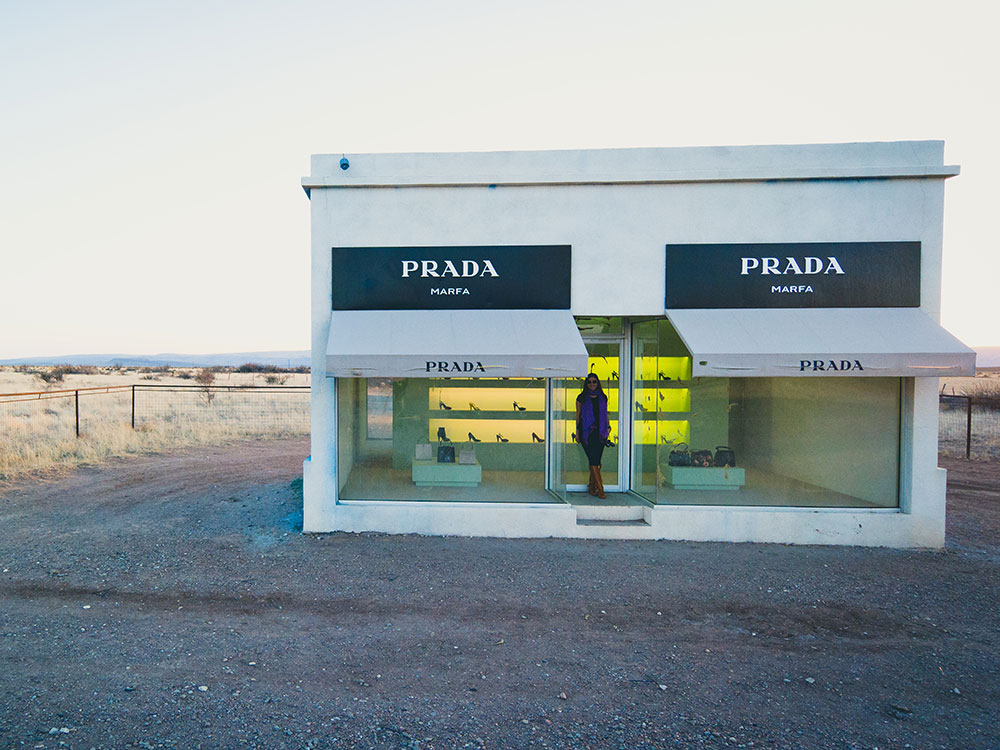Tourist destination and a major center for minimalist art including Building 98, the Chinati Foundation, artisan shops, historical architecture, a classic Texas town square, modern art installments, art galleries, and the Marfa lights
General Information
From El Paso (194 miles): Head southwest on E Mills Ave toward N Campbell St. Turn right at the 1st cross street onto N Campbell St. Use the right 2 lanes to turn right to merge onto I-10 E. Take exit 140A toward US-90/TX-54/Van Horn Dr. Merge onto Frontage Rd. Turn right onto US-90 E/Van Horn St.
Marfa is a city in the high desert of the Trans-Pecos in far West Texas, between the Davis Mountains and Big Bend National Park. The city was founded in the early 1880s as a water stop; the population increased during World War II, but growth has stalled and reversed somewhat since the late 20th century. Today, Marfa is a tourist destination and a major center for minimalist art. Attractions include Building 98, the Chinati Foundation, artisan shops, historical architecture, a classic Texas town square, modern art installments, art galleries, and the Marfa lights.

Marfa was founded in the early 1880s as a railroad water stop. The town was named "Marfa" (Russian for "Martha") at the suggestion of the wife of a railroad executive. Although some historians have hypothesized that the name came from a character in Fyodor Dostoevsky's novel The Brothers Karamazov, Marfa was actually named after Marfa Strogoff, a character in Jules Verne's novel Michael Strogoff. The town grew quickly during the 1920s.
The area around Marfa is known as a cultural center for contemporary artists and artisans. In 1971, Minimalist artist Donald Judd moved to Marfa from New York. After renting summer houses for a few years, he bought two large hangars and some smaller buildings and began to permanently install his art. While this started with his building in New York, the buildings in Marfa allowed him to install his works on a larger scale. In 1976, he bought the first of two ranches that became his primary places of residence, continuing a long love affair with the desert landscape surrounding Marfa. Later, with assistance from the Dia Art Foundation in New York, Judd acquired decommissioned Fort D.A. Russell, and began transforming the fort's buildings into art spaces in 1979. Judd's vision was to house large collections of individual artists' work on permanent display, as a sort of antimuseum. Judd believed the prevailing model of a museum, where art is shown for short periods of time, does not allow the viewer an understanding of the artist or their work as they intended.
Since Judd's death in 1994, two foundations have worked to maintain his legacy: the Chinati Foundation and Judd Foundation. Since its inauguration in 1986, Chinati has held an open-house event that attracts visitors from around the world to visit Marfa's art. Between 1997 and 2008, both foundations cosponsored this event. The Chinati Foundation now occupies more than 30 buildings in Marfa and has permanently displayed work by 13 artists.
In recent years, a new wave of artists has moved to Marfa to live and work. As a result, new gallery spaces have opened in the downtown area. The Crowley Theater and its annex host public events with seating for over 175 as a public service to nonprofit foundations. Furthermore, The Lannan Foundation has established a writers-in-residency program, a Marfa theater group has formed, and a multifunctional art space called Ballroom Marfa has begun to show art films, host musical performances, and exhibit other art installations. The city is also 37 miles (60 km) from Prada Marfa, a pop art exhibit, and is home to Cobra Rock Boot Company and The Wrong Store.
Apart from Donald Judd and modern art, Marfa may be most famous for the Marfa lights, visible on clear nights between Marfa and the Paisano Pass when one is facing southwest (toward the Chinati Mountains). According to the Handbook of Texas Online, "at times they appear colored as they twinkle in the distance. They move about, split apart, melt together, disappear, and reappear. Presidio County residents have watched the lights for over a hundred years." The first historical record of them dates to 1883. Presidio County has built a viewing station 9 miles east of town on US 67 near the site of the old air base. Each year, enthusiasts gather for the annual Marfa Lights Festival. The lights have been featured and mentioned in various media, including the television show Unsolved Mysteries and an episode of King of the Hill ("Of Mice and Little Green Men") and in an episode of the Disney Channel Original Series So Weird.

Prada Marfa is a permanent sculptural art installation by artists Elmgreen and Dragset, located 1.4 miles (2.3 km) northwest of Valentine, Texas, just off U.S. Highway 90 (US 90), and about 26 miles (42 km) northwest of the city of Marfa. The installation, in the form of a freestanding building—specifically a Prada storefront—was inaugurated on October 1, 2005. The artists described the work as a "pop architectural land art project."
Designed to resemble a Prada store, the building is made of "adobe bricks, plaster, paint, glass pane, aluminum frame, MDF, and carpet." The installation's door is nonfunctional. On the front of the structure there are two large windows displaying actual Prada wares, shoes and handbags, picked out and provided by Miuccia Prada from the fall/winter 2005 collection; Prada allowed Elmgreen and Dragset to use the Prada trademark for this work. Elmgreen and Dragset originally had wanted to place the sculpture elsewhere and was interested in a "Prada Nevada", but failed to find support in the state. They were then helped by the New York-based Art Production Fund (APF) which connected the artists with Ballroom Marfa in Marfa, Texas, a center of contemporary art and culture. The installation was then placed at a location northwest of Marfa near Valentine, Texas, where a local artist Boyd Elder served as caretaker for the installation.
Prada Marfa is located relatively close to Donald Judd's Chinati Foundation. The site-specific of Prada Marfa invites for a comparison with other art movements such as minimalism and land art, which are equally dependent on the site where they are placed. Prada Marfa relies almost entirely on its context for its critical effect. The "sculptural Intervention" can be interpreted as criticism of consumerism, luxury branding and gentrification, but whether intentionally or not, it is also argued it reinforces the capitalist values it criticizes. Therefore, this work of art experienced a change of meaning and gained an ambivalent moment, that the artists did not expect. Along a ledge that runs around the base of the building, hundreds of people have left business cards, weighed down by small rocks.
This article uses material from the Wikipedia article "Marfa, Texas", and "Prada Marfa", which is released under the Creative Commons Attribution-Share-Alike License 3.0